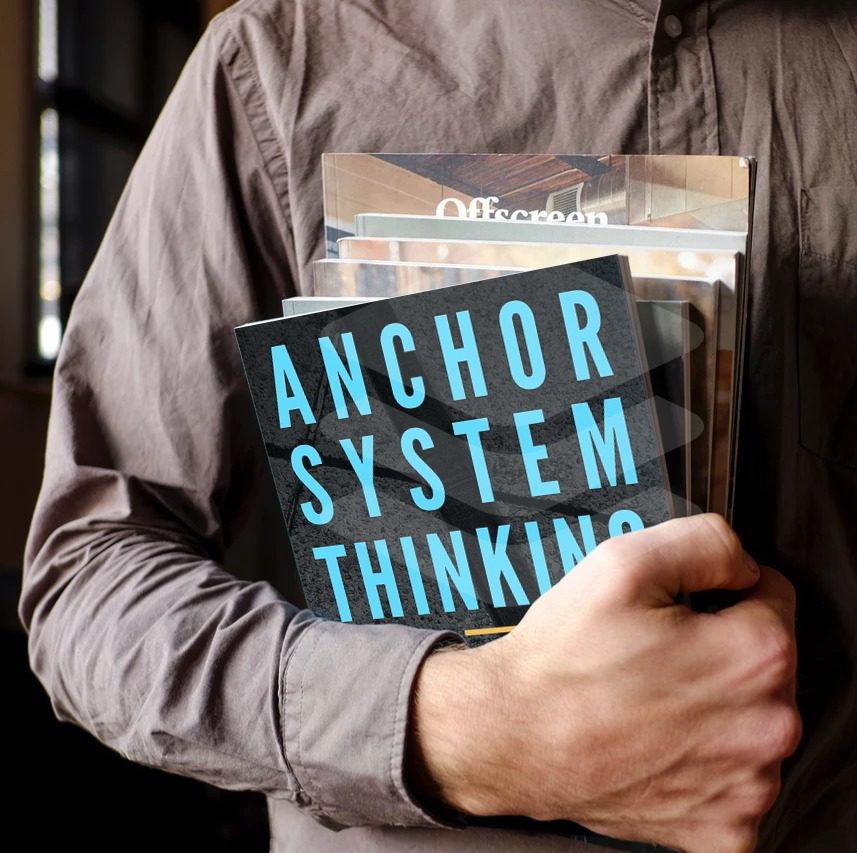An anchor means “principal support or something that serves to hold an object firmly.”[1][2] Being anchored may mean “to be related to something,” as in “this study is anchored to a theory” or “this man is anchored by his values.”
A typical setting for the usage of anchors is with vessels in the sea. An anchor is a device generally made of metal with a chain that holds the vessel to the bottom of the sea and prevents it from drifting due to currents or the wind. An “anchor cable” or “anchor chain” is used in larger vessels and is made of chain, cable, rope, or a combination of these. A vessel usually carries one or more anchors on board, which are considered temporary, while permanent anchors are left in a fixed location and are used for mooring.[3]
Can the anchoring metaphor and terminology be used to describe how we as humans are anchored to life? And can it be further extended to cover larger-scale entities?
This is what I call anchor system thinking. It is a holistic approach of thinking based on the sea anchors metaphor. Our anchors are mind imprints that are innate or result from external stimuli, and these anchors are points that hold us in a drifting sea (life). When we receive input from our senses, retrieve a thought from our memory, or try to delete a memory, anchor points affect how the data is processed (function) in our mind. This results in a change in our behaviors, actions, and decision-making.
By identifying our anchor points, we can understand where we stand (anchor maps) and can proactively plan where we are going. Just like we hold to anchor points, we are sometimes anchor points for others.
The anchor system is formed of five components:
· The vessel
· The medium
· The anchor
· The bed
· The chain
The vessel is tied with a chain and anchor to the bed of the medium. This is the five-component form of the anchor system. Anchor system thinking is not only used on the personal level, but it can also be applied to the organizational and societal levels for situational analysis, problem-solving, and strategic planning. In the following example, we will see part of its application on the organizational level.
The vessel
Organization
The medium
Market
The anchor point
The vessel is connected by a chain that ends with an anchor that hooks to the bed of the medium. The anchor(A), bed (B), and chain (C ) are the ABC, and together they form the anchor point.
There are four types of anchorpoints:
· Time anchor points
· Location anchor points
· Social network anchor points
· Entity anchor points
On the organizational level, anchor mapscan be used to illustrate the current anchor statusof any organization, such as a business company.
Now imagine you own a small online business, and you’d like to have an anchor mapfor it. Grab a pen and paper and start drawing:
Draw your .COM business at the center of the paper.
Define your:
– Time anchor points: Which anchor points hold you to your past, present, and future? What are your company goals? What is your company mission and vision?
– Location anchor points: Your physical business address, hosting DNS and server, mirror servers, etc.
– Social network anchor points: Your sister websites, competitors, suppliers, distributors, content editors and creators, designers, programmers, etc.
– Entity anchor points: What are your objective, subjective, and inter-subjective anchor points? What are your resources, code of conduct, terms and policies, etc.?
Improve: When you have your current anchor status, decide which anchor points are adding value to your start-up and need to be fostered, and which anchor points are holding you back and need to be deleted or fixed.
Anchor system thinking can be applied as a situational analysis tool on the personal, organizational, social, and even national levels. It is used to describe the current status and relationships in a meaningful and creative way.
Anchor system thinking can, therefore, be used to solve personal, business, political, societal, geopolitical, or relational dilemmas.
About the Author
Author A. I. Shoukry is an academic, writer, and podcaster. Author of the bestselling decision-making book In or Out: A Practical Guide to Decision Making. He recently published Anchor System Thinking: The Art of Situational Analysis, Problem Solving, and Strategic Planning for Yourself, Your Organization, and Society.
Twitter: @ashoukry
[1] Anchor | Definition of Anchor by Merriam-Webster n.d. https://www.merriam-webster.com/dictionary/anchor (accessed March 29, 2018).
[2] anchor | Definition of anchor in English by Oxford Dictionaries n.d. https://en.oxforddictionaries.com/definition/anchor (accessed March 30, 2018).
[3] Anchor — Wikipedia n.d. https://en.wikipedia.org/wiki/Anchor (accessed March 30, 2018).
